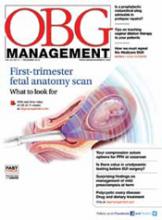“A STITCH IN TIME: THE B-LYNCH, HAYMAN, AND PEREIRA UTERINE COMPRESSION SUTURES”
ROBERT L. BARBIERI, MD (EDITORIAL; DECEMBER 2012)
Why and how I modified my compression-suture technique
I have used uterine compression sutures on several occasions but found it difficult to run one long suture up and over the uterus—so I improvised a different approach. I place one suture on the right edge of the hysterotomy incision (tying the suture) and another on the posterior of the uterus at the same level on the right. Using the free ends, I tie the sutures at the uterine fundus, compressing the uterus from the top down. I place another compression suture on the left side of the uterus, and sometimes in the middle. I generally use 0 polyglactin 10 (Vicryl), as chromic suture tends to break too easily.
This method is similar to the Hayman technique Dr. Barbieri describes, except that I use an anterior and posterior suture tied at the level of the hysterotomy and tied again at the uterine fundus.
Hershel Zis Weisberg, MD
New Richmond, Wisconsin
Dr. Barbieri responds
Thank you, Dr. Weisberg, for an excellent suggestion on improving the technique for a Hayman-like suture. I agree that it is often technically awkward to loop a single, very long suture over the uterus. I like the idea of using two sutures to simplify the placement and tying of the stitch.
“DIFFICULT FETAL EXTRACTION AT CESAREAN DELIVERY: WHAT SHOULD YOU DO?”
ROBERT L. BARBIERI, MD (EDITORIAL; JANUARY 2012)
Seeking more information on difficult fetal extraction
I was very pleased to find Dr. Barbieri’s very informative article on difficult fetal extraction at cesarean delivery. Because of an incident in our labor ward, we are planning some training around management of this obstetric emergency.
As a midwife, I can report that not many of us have had training in the “push technique” (an assist from a vaginal hand). Might there be a training package or other literature that could be used to develop our training program? I found Dr. Barbieri’s article and illustrations very helpful, especially FIGURE 2 (shown below).
As do many trusts in the National Health Service, we have mandatory skills drills on obstetric emergencies—but there is no drill for this particular scenario. I have found few articles on management that include diagrams like the ones in Dr. Barbieri’s column.
Krystyna Grey
Northampton, England
Dr. Barbieri responds
I thank Ms. Grey for relaying her experience related to difficult fetal extraction. I agree with her that it is very helpful to practice the delivering team’s response, including three commonly used maneuvers:
- the “hand from below”
- reverse breech extraction
- extension of the hysterotomy incision.
Few nurses and nurse midwives undergo formal training in providing a push to the fetal head from below, although they are often asked to help with this maneuver. One approach is to place the mother in a “frog-leg” position and insert a cupped hand into the vagina. Gently and slowly push the fetal head upward from the vagina back toward the uterus. Spread the cupped fingers out as much as possible before pushing on the fetal head to avoid applying excessive force at one location on the fetal skull. (Fracture of the fetal skull has occurred as a complication of the maneuver.) At the same time, the operating surgeon may apply gentle upward pressure to the fetal shoulder to help bring the fetal head to the hysterotomy incision so that it can be delivered more easily.
If the hand from below is ineffective, the surgeon should be prepared to perform a reverse breech extraction or extend the uterine hysterotomy incision to expedite delivery.1
We want to hear from you! Tell us what you think.



